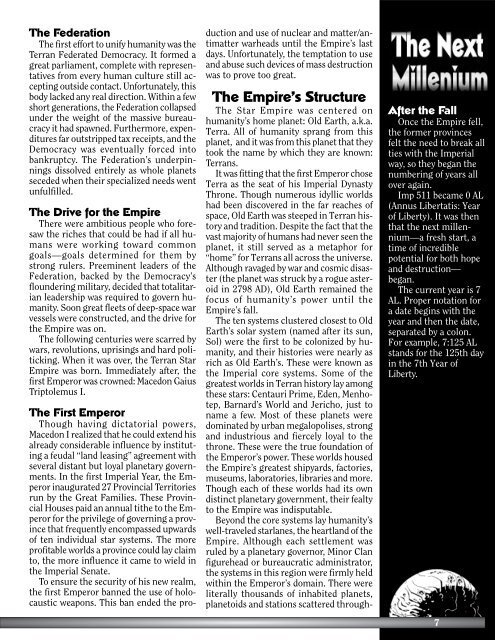Create successful ePaper yourself
Turn your PDF publications into a flip-book with our unique Google optimized e-Paper software.
The Federation<br />
The first effort to unify humanity was the<br />
Terran Federated Democracy. It formed a<br />
great parliament, complete with representatives<br />
from every human culture still accepting<br />
outside contact. Unfortunately, this<br />
body lacked any real direction. Within a few<br />
short generations, the Federation collapsed<br />
under the weight of the massive bureaucracy<br />
it had spawned. Furthermore, expenditures<br />
far outstripped tax receipts, and the<br />
Democracy was eventually forced into<br />
bankruptcy. The Federation’s underpinnings<br />
dissolved entirely as whole planets<br />
seceded when their specialized needs went<br />
unfulfilled.<br />
The Drive for the Empire<br />
There were ambitious people who foresaw<br />
the riches that could be had if all humans<br />
were working toward common<br />
goals—goals determined for them by<br />
strong rulers. Preeminent leaders of the<br />
Federation, backed by the Democracy’s<br />
floundering military, decided that totalitarian<br />
leadership was required to govern humanity.<br />
Soon great fleets of deep-space war<br />
vessels were constructed, and the drive for<br />
the Empire was on.<br />
The following centuries were scarred by<br />
wars, revolutions, uprisings and hard politicking.<br />
When it was over, the Terran Star<br />
Empire was born. Immediately after, the<br />
first Emperor was crowned: Macedon Gaius<br />
Triptolemus I.<br />
The First Emperor<br />
Though having dictatorial powers,<br />
Macedon I realized that he could extend his<br />
already considerable influence by instituting<br />
a feudal “land leasing” agreement with<br />
several distant but loyal planetary governments.<br />
In the first Imperial Year, the Emperor<br />
inaugurated 27 Provincial Territories<br />
run by the Great Families. These Provincial<br />
Houses paid an annual tithe to the Emperor<br />
for the privilege of governing a province<br />
that frequently encompassed upwards<br />
of ten individual star systems. The more<br />
profitable worlds a province could lay claim<br />
to, the more influence it came to wield in<br />
the Imperial Senate.<br />
To ensure the security of his new realm,<br />
the first Emperor banned the use of holocaustic<br />
weapons. This ban ended the pro-<br />
duction and use of nuclear and matter/antimatter<br />
warheads until the Empire’s last<br />
days. Unfortunately, the temptation to use<br />
and abuse such devices of mass destruction<br />
was to prove too great.<br />
The Empire’s Structure<br />
The Star Empire was centered on<br />
humanity’s home planet: Old Earth, a.k.a.<br />
Terra. All of humanity sprang from this<br />
planet, and it was from this planet that they<br />
took the name by which they are known:<br />
Terrans.<br />
It was fitting that the first Emperor chose<br />
Terra as the seat of his Imperial Dynasty<br />
Throne. Though numerous idyllic worlds<br />
had been discovered in the far reaches of<br />
space, Old Earth was steeped in Terran history<br />
and tradition. Despite the fact that the<br />
vast majority of humans had never seen the<br />
planet, it still served as a metaphor for<br />
“home” for Terrans all across the universe.<br />
Although ravaged by war and cosmic disaster<br />
(the planet was struck by a rogue asteroid<br />
in 2798 AD), Old Earth remained the<br />
focus of humanity’s power until the<br />
Empire’s fall.<br />
The ten systems clustered closest to Old<br />
Earth’s solar system (named after its sun,<br />
Sol) were the first to be colonized by humanity,<br />
and their histories were nearly as<br />
rich as Old Earth’s. These were known as<br />
the Imperial core systems. Some of the<br />
greatest worlds in Terran history lay among<br />
these stars: Centauri Prime, Eden, Menhotep,<br />
Barnard’s World and Jericho, just to<br />
name a few. Most of these planets were<br />
dominated by urban megalopolises, strong<br />
and industrious and fiercely loyal to the<br />
throne. These were the true foundation of<br />
the Emperor’s power. These worlds housed<br />
the Empire’s greatest shipyards, factories,<br />
museums, laboratories, libraries and more.<br />
Though each of these worlds had its own<br />
distinct planetary government, their fealty<br />
to the Empire was indisputable.<br />
Beyond the core systems lay humanity’s<br />
well-traveled starlanes, the heartland of the<br />
Empire. Although each settlement was<br />
ruled by a planetary governor, Minor Clan<br />
figurehead or bureaucratic administrator,<br />
the systems in this region were firmly held<br />
within the Emperor’s domain. There were<br />
literally thousands of inhabited planets,<br />
planetoids and stations scattered through-<br />
After the Fall<br />
Once the Empire fell,<br />
the former provinces<br />
felt the need to break all<br />
ties with the Imperial<br />
way, so they began the<br />
numbering of years all<br />
over again.<br />
Imp 511 became 0 AL<br />
(Annus Libertatis: Year<br />
of Liberty). It was then<br />
that the next millennium—a<br />
fresh start, a<br />
time of incredible<br />
potential for both hope<br />
and destruction—<br />
began.<br />
The current year is 7<br />
AL. Proper notation for<br />
a date begins with the<br />
year and then the date,<br />
separated by a colon.<br />
For example, 7:125 AL<br />
stands for the 125th day<br />
in the 7th Year of<br />
Liberty.<br />
7


